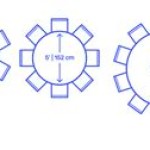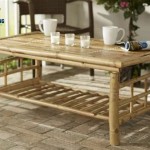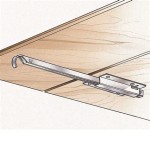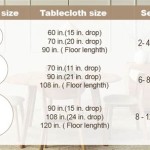The Enduring Appeal of the Picnic Style Dining Room Table
The picnic style dining room table, characterized by its robust construction, communal seating, and rustic aesthetic, has experienced a resurgence in popularity. Moving beyond its traditional outdoor setting, this durable and inviting furniture piece is finding a comfortable and stylish place within modern homes. This article will explore the defining features of the picnic style dining room table, discuss its suitability for various living spaces, and outline the key considerations when selecting such a table for a home.
The picnic table archetype is intrinsically linked to outdoor gatherings and casual meals. Its inherent design prioritizes function and durability, often featuring solid wood construction and a simple, unadorned aesthetic. Transplanting this design into the formal or semi-formal setting of a dining room introduces a unique blend of informality and practicality. This contrast appeals to homeowners seeking a relaxed yet stylish dining experience.
The incorporation of a picnic style table into a dining room often signals a shift towards less formal entertaining and a greater emphasis on shared meals and conversation. The long, bench-style seating encourages interaction and creates a sense of community, making it ideal for families with children or those who frequently host large gatherings. Furthermore, the robust nature of the construction provides assurance that the table can withstand the rigors of daily use and the occasional spill or mishap.
Defining Features of the Picnic Style Dining Room Table
The picnic style dining room table, while borrowing from its outdoor counterpart, often incorporates refinements to suit the indoor environment. Understanding its key characteristics is essential for discerning what constitutes a true picnic style table and how those features contribute to its overall appeal and functionality. Key features includes construction materials, seating arrangements, and table top design.
Firstly, the material used in construction is a defining characteristic. Traditionally, picnic tables are crafted from durable, weather-resistant woods like cedar, redwood, or pressure-treated pine. However, when adapted for indoor use, options expand to include hardwoods like oak, maple, or walnut, which offer enhanced aesthetic appeal and resistance to wear and tear. Metal frames, often powder-coated for durability, are also common alternatives, providing a modern industrial aesthetic. The choice of material will significantly influence the table's overall style, longevity, and maintenance requirements.
Secondly, the seating arrangement is a critical element. The quintessential picnic table features attached benches, offering a fixed seating capacity. While this design is often replicated in indoor versions, many modern interpretations offer detachable benches or even allow for the use of chairs on the ends. This flexibility is particularly beneficial in smaller dining rooms where fixed benches might restrict movement or visual flow. The bench style encourages a more communal dining experience, fostering conversation and a sense of togetherness as individuals share space rather than being separated into individual chairs.
Thirdly, the tabletop design contributes significantly to the aesthetic and functional appeal of the table. Traditional picnic tables often feature simple, flat surfaces made from planks of wood. Contemporary designs, however, may incorporate more elaborate details, such as inlaid patterns, live edges, or even epoxy resin fills. The tabletop size and shape also vary considerably, ranging from rectangular to oval or even round, allowing for greater customization to suit different dining room layouts and seating requirements. The finish of the tabletop, whether stained, painted, or left natural, further influences the overall aesthetic and its compatibility with the existing décor.
Suitability for Various Living Spaces
The picnic style dining room table is not a one-size-fits-all solution. Its suitability depends heavily on the size and style of the dining room, the homeowner's lifestyle, and the desired aesthetic. Careful consideration of these factors is crucial for ensuring that the table complements the space and meets the functional needs of the household.
In larger, open-concept living spaces, a generously sized picnic style table can serve as a focal point, defining the dining area and providing ample seating for both everyday meals and large gatherings. The robust construction and informal aesthetic of the table can also help to balance the formality of the space, creating a more relaxed and inviting atmosphere. In such settings, consider opting for a table with detachable benches or incorporating chairs on the ends to provide greater seating flexibility and visual interest.
In smaller dining rooms, a scaled-down version of the picnic style table might be more appropriate. A narrower table with shorter benches can maximize floor space and prevent the room from feeling cramped. Alternatively, a table with a single bench on one side and chairs on the other can offer a compromise between the traditional picnic table aesthetic and the need for individual seating. Light-colored wood finishes or metal frames can further enhance the sense of space and prevent the table from visually overwhelming the room.
For those seeking a more formal dining experience, the picnic style table may still be a viable option, but careful consideration must be given to the materials and styling. Opting for a table crafted from high-quality hardwoods with a refined finish can elevate the aesthetic and create a more sophisticated look. Pairing the table with upholstered chairs instead of benches can further enhance the formality and provide greater comfort for extended meals. The addition of a tablecloth and elegant tableware can also transform the table and create a more refined dining atmosphere.
Key Considerations When Selecting a Picnic Style Dining Room Table
Choosing the right picnic style dining room table requires careful consideration of several factors, ranging from size and materials to style and budget. By addressing these considerations upfront, homeowners can ensure that they select a table that not only complements their dining room but also meets their functional needs and aesthetic preferences.
Firstly, the size of the table should be proportionate to the size of the dining room. Measure the available space carefully, taking into account the need for adequate clearance around the table for comfortable movement. The table should be large enough to comfortably accommodate the typical number of diners but not so large that it overwhelms the room or obstructs pathways. Consider the possibility of extending the table with leaves or using chairs on the ends to accommodate larger gatherings.
Secondly, the material selection should align with the desired aesthetic and the level of maintenance that the homeowner is willing to undertake. Hardwoods like oak, maple, and walnut offer durability and visual appeal but require regular cleaning and occasional refinishing. Softwoods like pine and cedar are more affordable but may be more susceptible to scratches and dents. Metal frames provide a modern, industrial aesthetic and are relatively low-maintenance, but may not appeal to those seeking a more traditional look. The finish of the table should also be considered, with options ranging from natural stains to painted finishes and protective coatings.
Thirdly, the style of the table should complement the existing décor of the dining room. Consider the color scheme, furniture styles, and overall aesthetic of the space. A rustic picnic table might be a good fit for a farmhouse-style dining room, while a sleek metal-framed table might be more appropriate for a modern or industrial-style space. The detailing of the table, such as the shape of the legs, the design of the tabletop, and the style of the benches or chairs, should also be carefully considered to ensure a cohesive and harmonious look.
Finally, the budget should be a primary consideration. Picnic style dining room tables range widely in price, depending on the size, materials, and craftsmanship. Set a realistic budget upfront and research different options to find a table that meets the desired criteria without exceeding financial constraints. Consider exploring online retailers, local furniture stores, and custom furniture makers to compare prices and find the best value for money. It's also advisable to factor in the cost of any additional items, such as chairs, cushions, or tablecloths, that may be needed to complete the dining room setup.

A Picnic Table For Your Kitchen Dining Room Bench Modern

Rustic Picnic Style Dining Table Wildfire Interiors

Black Indoor Picnic Style Dining Embrace The Relaxed Of Tables Decoist Rustic Room Table Decor

Hand Made Picnic Table And Dining Room By Ivy League Dropout Designs Custommade Com

Rustic Farmhouse Kitchen Table Set Littlerustic

Noble House Cottage 3 Piece Brushed Gray Wood Picnic Style Dining Set 8085 2 The Home Depot

32 Indoor Picnic Table Ideas For A Relaxed Feel Digsdigs

Rustic Picnic Style Dining Table Wildfire Interiors

Rustic Picnic Style Dining Table

Rustic Picnic Style Dining Table Wildfire Interiors








